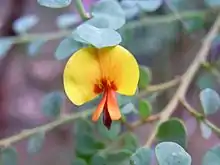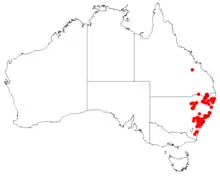Bossiaea rhombifolia
Bossiaea rhombifolia, is a species of flowering plant in the pea family found in eastern Australia. An upright shrub to two metres tall. Branches are hairless and mostly flat, particularly when young. A most attractive plant when in full flower.
| Bossiaea rhombifolia | |
|---|---|
 | |
| Blue Mountains National Park, Australia | |
| Scientific classification | |
| Kingdom: | |
| (unranked): | |
| (unranked): | |
| (unranked): | |
| Order: | |
| Family: | |
| Genus: | |
| Species: | B. rhombifolia |
| Binomial name | |
| Bossiaea rhombifolia | |
 | |
| Occurrence data from AVH | |
Leaves are angular ovate or rhomboid in shape, 3 to 10 mm long. Leaf stipules are triangular, 1 mm long.
Flowers are the typical yellow and red of this “bacon and egg” wildflower group, usually flowering between July and October.
It occurs from Wadbilliga National Park in southern New South Wales up north to Queensland. The habitat is chiefly the drier eucalyptus forest.[1]
The specific epithet rhombifolia refers to the diamond-shaped leaves in some specimens.[2]
Two forms are recognised:
- Bossiaea rhombifolia subsp. concolor found in inland areas such as the Pilliga Scrub
- Bossiaea rhombifolia subsp. rhombifolia more usually found on the coast and ranges.
This plant first appeared in scientific literature in 1825, in the Prodromus Systematis Naturalis Regni Vegetabilis, authored by the Swiss botanist, Augustin Pyramus de Candolle.
References
- "Bossiaea rhombifolia". PlantNET - NSW Flora Online. Retrieved 4 May 2011.
- Les Robinson - Field Guide to the Native Plants of Sydney, ISBN 978-0-7318-1211-0 page 74